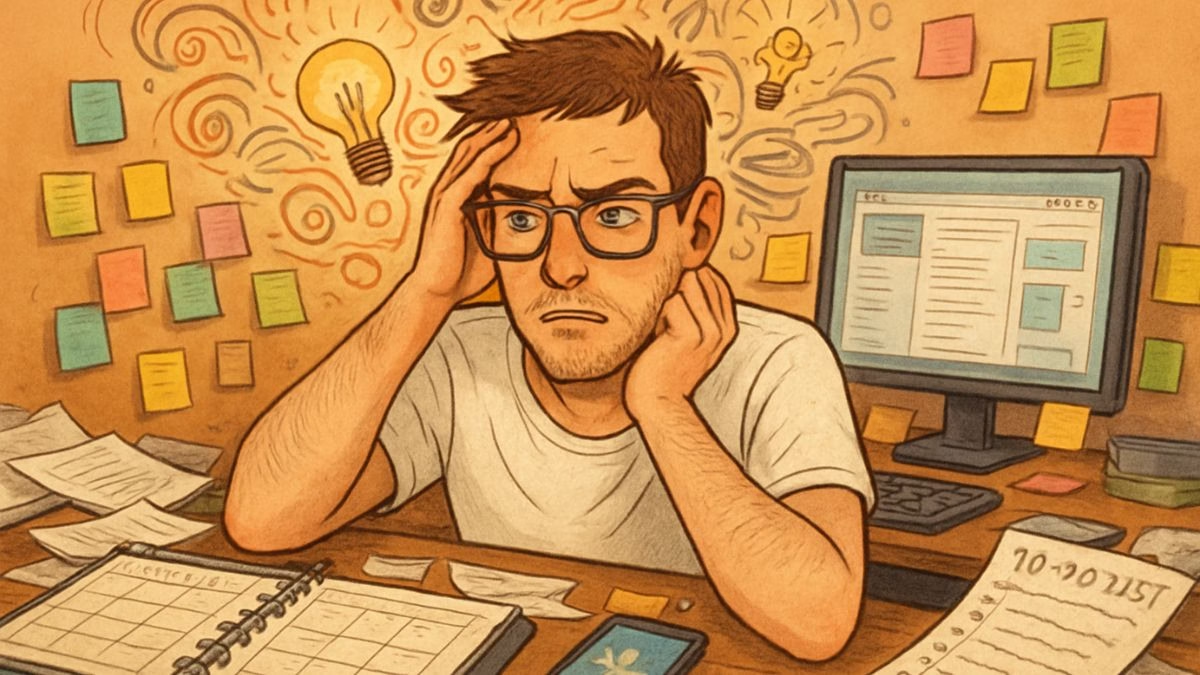Audio Article
For most of her life, Sarah, a 42-year-old graphic designer with a razor-sharp wit and a portfolio that could make seasoned art directors weep, operated under a cloud of self-recrimination. She was the queen of the last-minute save, pulling all-nighters fueled by caffeine and sheer panic to deliver breathtaking work just under the wire. Her apartment was a testament to “creative chaos,” with bills paid just shy of the due date and laundry piles that took on lives of their own. Relationships often fizzled out, her partners frustrated by her perceived forgetfulness and emotional intensity. The ubiquitous narrative she told herself, reinforced by a world that values punctuality and order, was simple: she was lazy, undisciplined, and fundamentally flawed.
Then, a casual conversation about her son’s struggles in school led her down an internet rabbit hole that culminated in a life-altering epiphany. At age 41, Sarah was diagnosed with Attention-Deficit/Hyperactivity Disorder (ADHD). “It was like someone handed me the instruction manual to my own brain for the first time,” she recounts. “All these things I saw as moral failures were suddenly reframed as symptoms of a neurological condition. I wasn’t lazy; my brain’s executive system was just… different.”
Sarah’s story is a powerful echo of a reality for millions of adults, many of whom are diagnosed late in life after decades of confusion and shame. ADHD is one of the most misunderstood conditions of our time, still widely perceived as a childhood affliction of hyperactive boys who can’t sit still. This caricature does a profound disservice to the adults who live with it, whose struggles are often invisible and far more nuanced. The core of adult ADHD isn’t merely a battle with distraction; it’s a profound and persistent challenge with regulation—of attention, of emotion, of motivation, and of action. It is not a failure of will, but a difference in brain wiring.
The Brain’s CEO: Understanding Executive Functions
To grasp the reality of adult ADHD, one must first understand the concept of executive functions. Think of these as the CEO of your brain, headquartered in the prefrontal cortex. This ‘CEO’ is responsible for a suite of sophisticated mental skills we need to get things done: planning, organizing, initiating tasks, managing time, regulating emotions, and maintaining focus. For a neurotypical brain, these processes happen so automatically they’re almost invisible. For the ADHD brain, this CEO is chronically overworked, easily distracted, and has a penchant for misplacing important memos.
Dr. Russell Barkley, a leading clinical psychologist and ADHD expert, has been instrumental in shifting the conversation from attention to self-regulation. He posits that ADHD is fundamentally a disorder of the brain’s ability to inhibit responses and regulate behavior over time. It’s not that people with ADHD can’t pay attention; in fact, they can often “hyperfocus” with laser-like intensity on things that genuinely interest them. The problem lies in directing that attention, especially towards tasks that are boring, difficult, or lack an immediate reward.
The Time Blindness Conundrum
One of the most bewildering aspects of ADHD is a phenomenon often called “time blindness.” This is an innate difficulty in perceiving the passage of time, estimating how long a task will take, and mentally mapping out a future timeline. For someone with ADHD, time isn’t a linear progression of minutes and hours; it’s a vague concept of “now” and “not now.”
“To me, a deadline that’s two weeks away feels exactly the same as one that’s two months away. It’s in the ‘not now’ category,” explains Michael, a 35-year-old software engineer diagnosed at 32. “Then, suddenly, it becomes ‘now’—as in, it’s due now—and a jolt of panic is the only thing that can galvanize me into action.” This isn’t procrastination in the classic sense of choosing to delay a task. It’s a genuine perceptual deficit. This explains why an ADHD adult might be chronically late despite their best intentions, or why they can spend six hours on a task they swore would only take one. They aren’t being disrespectful; their internal clock is simply not synchronized with the external world.
The Motivation Engine and the Dopamine Chase
Why is it so hard to start the “boring” tasks? The answer may lie in neurochemistry, specifically with the neurotransmitter dopamine. Dopamine is a key player in the brain’s reward and motivation system. It’s the chemical that says, “Hey, this is important! Pay attention and you’ll get a reward.” Research suggests that the ADHD brain has a dysfunctional dopamine system. It’s as if the “motivation engine” is constantly running low on fuel.
This explains why people with ADHD are often drawn to high-stimulation activities, novelty, and immediate gratification. These things provide the dopamine hit their brain craves. A mundane task like filling out a spreadsheet offers virtually no dopamine reward, so the brain’s CEO simply refuses to allocate resources to it. However, the imminent threat of a looming deadline triggers a surge of adrenaline and stress hormones, which can act as a powerful, albeit unhealthy, stimulant to finally get the brain in gear. This is why so many adults with ADHD are masters of crisis management but struggle with routine maintenance. They are not adrenaline junkies by choice; their brains are wired to respond to urgency, not importance.
The Emotional Rollercoaster: Beyond Hyperactivity
The “H” in ADHD stands for hyperactivity, but in adults, this rarely manifests as the stereotypical bouncing-off-the-walls behavior. Instead, it often turns inward, presenting as a relentless internal restlessness, a mind that never stops chattering, or a constant need to be busy. More significantly, the “H” can be seen in emotional hyper-reactivity.
This is perhaps the most overlooked and damaging aspect of adult ADHD. The same lack of inhibition that might cause a child to blurt something out can cause an adult to experience emotions with a breathtaking and overwhelming intensity.
Flooded Feelings and Rejection Sensitivity
Many adults with ADHD experience what is known as emotional dysregulation. Their emotions come on faster, feel more intense, and are harder to manage than in their neurotypical peers. A small frustration can quickly escalate into explosive anger. A minor setback can plunge them into a deep well of despair. This isn’t a lack of maturity; it’s a neurological reality. The brain’s regulatory system, which should act as a damper on emotional responses, is simply not doing its job effectively.
Compounding this is a trait known as Rejection Sensitive Dysphoria (RSD). While not an official diagnosis, it is a concept widely recognized by ADHD experts. RSD is an extreme emotional sensitivity and pain triggered by the perception of being rejected, teased, or criticized. It can feel like a sudden, overwhelming, and physically painful blow.
“For years, I thought I was just pathologically insecure,” Sarah shares. “If a client gave me even minor feedback, I wouldn’t just hear the critique; I would feel this wave of shame, this internal narrative that I was a complete fraud. I’d ruminate on it for days.” This isn’t just being “too sensitive.” It’s a debilitating experience that can have a devastating impact on careers and relationships, leading individuals to become people-pleasers to avoid criticism or to avoid social situations altogether for fear of rejection.
Navigating Life, Love, and Work with a Different Brain
A late-life diagnosis of ADHD is not a cure, but it is a roadmap. It provides a new framework for understanding past struggles and developing strategies for a better future. The goal isn’t to “fix” the ADHD brain, but to learn how to work with its unique operating system.
Architecting Your Environment
Since the ADHD brain struggles with internal regulation, the most effective strategies often involve externalizing that regulation. This means creating an environment rich with systems, tools, and prompts that do the work the brain’s CEO struggles with.
For time management, this might mean using multiple alarms, visual timers, and body-doubling (working alongside another person to stay on task). For organization, it’s about creating a “home” for everything and using clear bins, labels, and checklists to offload the mental burden of remembering. It’s about a “don’t put it down, put it away” philosophy.
For motivation, the key is to reverse-engineer the brain’s reward system. This involves breaking down large, intimidating tasks into tiny, manageable steps and then pairing them with an immediate reward. “I used to have ‘clean the kitchen’ on my to-do list, which was so overwhelming I’d never start,” says Michael. “Now, my list says ‘put dishes in sink,’ ‘wipe one counter.’ And after I do it, I let myself listen to five minutes of a podcast. It sounds silly, but it’s about creating those little dopamine hits that my brain needs to stay engaged.”
The Relationship Recalibration
In relationships, an ADHD diagnosis can be a watershed moment. For the non-ADHD partner, behaviors that were once interpreted as carelessness or a lack of love—like forgetting an important date or zoning out mid-conversation—can be re-contextualized as symptoms. This doesn’t excuse the behavior, but it removes the sting of perceived malice and opens the door for collaborative problem-solving.
Successful couples learn to communicate explicitly about their needs. The ADHD partner might need gentle, non-judgmental reminders. The non-ADHD partner might need to understand that their loved one’s attention wandering is not a reflection of their affection. Therapy, both individual and couples, can be invaluable in navigating this new understanding and developing a shared language and toolkit. The burden of adaptation shouldn’t fall solely on the person with ADHD; it’s about both partners learning to dance to a new rhythm.
The journey for an adult with ADHD is one of profound self-discovery and radical self-acceptance. It’s about shedding a lifetime of shame and culpability and recognizing that their brain is not broken, but different. It’s about learning to celebrate the myriad strengths that often accompany this neurotype—creativity, out-of-the-box problem-solving, resilience, and a deep capacity for empathy. By reframing ADHD not as a deficit of character but as a challenge of regulation, we can finally move beyond the stigma and unlock the immense potential of these unique and powerful minds. Sarah, the graphic designer, puts it best: “I still pull the occasional all-nighter. But now, it’s a choice I make for a project I’m passionate about, not a frantic scramble born of shame. I’ve learned to be the creative director of my own brain, and that has made all the difference.”
MagTalk Discussion
Focus on Language
Vocabulary and Speaking
So, let’s pull back the curtain and look at some of the language that powered that article. Words are the building blocks of understanding, and choosing the right one can be the difference between a flat statement and an idea that truly lands. We’re going to explore some of these words not as dictionary entries, but as tools you can add to your own verbal toolbox. First on our list is ubiquitous. I used it to describe the narrative Sarah told herself about being lazy, calling it a “ubiquitous narrative.” If something is ubiquitous, it seems to be everywhere at once. It’s omnipresent. Think about smartphones. They are ubiquitous in modern society. You see them in cafes, on buses, in classrooms. The air we breathe is ubiquitous. When I say Sarah’s narrative of self-criticism was ubiquitous, I mean it was a constant, pervasive presence in her life, coloring every experience. It’s a more powerful and formal word than “common” or “everywhere.” You could say, “In the summer, the sound of ice cream trucks is ubiquitous in my neighborhood,” or “The company’s logo has become ubiquitous thanks to their aggressive marketing.” It’s a great word for describing something that has saturated an environment or a culture.
Next up, let’s talk about epiphany. The article says Sarah had a “life-altering epiphany” when she discovered ADHD. An epiphany is more than just a good idea. It’s a moment of sudden and profound realization or revelation. It’s the “Aha!” moment when everything suddenly clicks into place and you see something in a completely new light. The classic image is a lightbulb switching on above someone’s head. For Sarah, understanding that her struggles were neurological, not moral, was an epiphany that changed her entire self-concept. You might have an epiphany about a difficult problem you’ve been trying to solve, or about the true nature of a relationship. It implies a dramatic and significant shift in understanding. For instance, “After years of struggling in his career, he had an epiphany that his true passion was carpentry, not accounting.” It’s a word reserved for those big, perspective-shifting moments.
Let’s look at the word culpability. I wrote that an ADHD diagnosis is about “shedding a lifetime of shame and culpability.” Culpability is a strong word that means responsibility for a fault or wrong; it’s about blame. It’s related to the word “culprit,” the person who is guilty of a crime. When you feel culpability, you feel that you are to blame, that the fault is yours. For decades, adults with undiagnosed ADHD carry a heavy burden of culpability for their struggles with time management, organization, and emotional regulation. The diagnosis helps to shift that feeling of blame from their character to their neurology. In a legal context, a lawyer might argue for their client’s lack of culpability. In a personal context, you might say, “He refused to accept any culpability for the project’s failure.” It’s a formal word for a heavy concept.
Now for a more active word: galvanize. The article states that for Michael, “a jolt of panic is the only thing that can galvanize him into action.” To galvanize someone is to shock or excite them into taking action. The word has a fascinating origin; it comes from the scientist Luigi Galvani, who discovered that he could make a dead frog’s legs twitch by applying an electrical current. So, the word carries that sense of an electric jolt, a sudden impetus. A powerful speech can galvanize a crowd to protest. A tragic event can galvanize a community to raise money. For Michael, the adrenaline of a deadline is the ‘electric shock’ that galvanizes his brain to finally engage with a task. It’s a much more dynamic verb than simply “motivate” or “encourage.”
Let’s explore the word conundrum. I described time blindness as a “bewildering aspect” and a “conundrum.” A conundrum is a confusing and difficult problem or question. It’s a kind of puzzle that’s hard to solve. A riddle is a type of conundrum. When something is a conundrum, it’s not just a problem; it’s a perplexing one that might not have an easy answer. The fact that someone can be brilliant and creative yet unable to pay a bill on time is a conundrum for people who don’t understand ADHD. In your own life, you might face a conundrum like, “How can I afford to travel when I also need to save for a house?” It implies a complex problem with conflicting elements.
Let’s talk about the word myriad. The article mentions that ADHD is accompanied by a “myriad of strengths.” Myriad means a countless or extremely great number of people or things. It comes from an ancient Greek word for the number 10,000, so it implies a vast, almost uncountable quantity. You could say “a myriad of stars” in the night sky. When I say a “myriad of strengths,” I’m emphasizing that the positive qualities associated with ADHD—like creativity and resilience—are numerous and diverse. It’s a more elegant and impactful word than “many” or “a lot of.” You could say, “New York City offers a myriad of dining options,” to convey the immense variety available.
Next is a slightly more academic term, but one that’s incredibly useful: executive functions. We defined this in the article as the “CEO of your brain.” This phrase refers to a specific set of high-level mental processes that allow us to plan, focus, remember instructions, and juggle multiple tasks. While it’s a term from neuroscience, it’s becoming more common in everyday discussions about productivity and mental health. Understanding this concept allows for more precise conversations. Instead of saying “I’m bad at getting things done,” you could say, “I struggle with the executive function of task initiation.” It helps depersonalize the problem. It’s not that you are flawed; it’s that a specific cognitive skill is a challenge for you. This precision is empowering.
Let’s look at the adjective impetuous. This wasn’t in the final article, but it’s a perfect word to describe one facet of ADHD. To be impetuous is to act or do something quickly and without thought or care. It’s a kind of impulsive behavior. Someone who is impetuous might quit their job on a whim or make a large purchase without considering the consequences. It’s driven by feeling rather than logic. You can see how this relates to the ADHD challenge of inhibition. An impetuous decision is one made in the heat of the moment. For example, “In an impetuous move, he booked a one-way ticket to Brazil.” It often carries a slightly negative connotation, suggesting a lack of foresight.
Another crucial term is neurodivergent. This is an umbrella term that describes people whose brains process, learn, and/or behave differently from what is considered “typical.” It’s not a medical term, but a concept from the disability rights movement. ADHD falls under the neurodivergent umbrella, along with autism, dyslexia, and other conditions. It’s a powerful reframe. Instead of seeing these conditions as “disorders” or “deficits,” the concept of neurodivergence views them as natural variations in the human brain. The opposite is neurotypical, which refers to someone with typical brain development and functioning. Using this language helps reduce stigma. You’re not saying someone is “abnormal”; you’re saying they are neurodivergent. It promotes a more inclusive understanding of how different minds work.
Finally, let’s look at the phrase watershed moment. The article says that for a couple, “an ADHD diagnosis can be a watershed moment.” A watershed is a high ridge of land from which water flows down in two different directions. Metaphorically, a watershed moment is a turning point, a crucial event or decision that marks a significant change. After a watershed moment, things are never the same. A diagnosis can be a watershed moment because all the history before it is seen in a new light, and the future path is forever altered. Other examples could be, “The invention of the internet was a watershed moment in human history,” or “Deciding to move abroad was a watershed moment in my life.” It signifies a definitive and transformative turning point.
Now, let’s shift to speaking. Today’s speaking focus is on how to explain a complex personal concept without being defensive or apologetic. This is a skill that everyone needs, but it’s especially critical when you have to explain an invisible challenge like ADHD, anxiety, or even just a personal boundary. The goal is to be clear, confident, and informative. The formula is simple: State the fact, explain the impact, and suggest a solution. Notice, there’s no “I’m sorry, but…” or “I know this is annoying, but…”
Let’s practice using our vocabulary. Imagine you need to explain to a new project manager why you work best with written, not verbal, instructions.
A defensive/apologetic approach might be: “I’m so sorry, I know it’s a pain, but I’m just really bad at remembering things people tell me. My brain is all over the place.” This communicates shame and a lack of confidence.
Now, let’s try the assertive formula:
- State the fact: “I work most effectively when I have instructions in writing.” (Clear, direct, no apology.)
- Explain the impact: “My brain struggles with the executive function of auditory processing, which means verbal instructions can get jumbled. Having it in writing allows me to track the myriad details and ensure I don’t miss anything.” (Uses precise language, explains why, and frames it as a strategy for success, not a weakness.)
- Suggest a solution: “A quick follow-up email with bullet points after our meetings would be incredibly helpful for me to perform at my best.” (This is collaborative and solution-focused.)
See the difference? It’s confident and educational. Your challenge this week is to find one opportunity to practice this. It doesn’t have to be about ADHD. Maybe you need to tell a friend you’re an introvert and can’t go to three parties in one weekend.
- Fact: “I need a lot of quiet downtime to recharge.”
- Impact: “Going to too many social events in a row leaves me feeling completely drained and unable to be present.”
- Solution: “I’d love to go to the Friday party, but I’ll have to skip the one on Saturday so I can be at my best.”
Try it out. It might feel a bit formal at first, but it’s a powerful way to communicate your needs with respect for yourself and others. It’s not about making excuses; it’s about providing instructions for how to work with you successfully.
Grammar and Writing
Now, let’s move from speaking with clarity to writing with depth. The topic of ADHD, and indeed any story about personal struggle and discovery, is rich with complexity, cause-and-effect, and contrasting ideas. To capture this nuance in your writing, you need to move beyond simple sentences and embrace the power of the complex sentence.
The Writing Challenge:
Write a short, reflective piece (around 500-700 words) from the perspective of someone who has recently had an epiphany about a long-standing personal struggle. This doesn’t have to be about ADHD. It could be about anxiety, a creative block, a recurring pattern in relationships, or a professional challenge. The goal is to capture the “before and after” of this realization. Your piece should explore the contrast between the old narrative (e.g., “I was lazy/unlovable/not good enough”) and the new understanding. How has this watershed moment changed your perception of the past and your hope for the future?
To make this piece powerful, we’re going to focus on two key grammatical and stylistic tools: Complex Sentences with Subordinate Clauses and Rhetorical Questions.
Grammar Deep Dive: The Art of the Complex Sentence
A simple sentence has one independent clause (a complete thought). “I missed the deadline.” It’s clear, but it lacks context. A complex sentence has one independent clause and at least one dependent (or subordinate) clause. These dependent clauses can’t stand on their own but add crucial information about the why, how, when, or under what condition of the main clause. They are your tools for showing sophisticated relationships between ideas.
The magic happens with the words that begin these clauses, called subordinating conjunctions. Let’s look at a few key categories:
- To Show Cause/Effect:because, since, as
- Simple: “I always felt ashamed. I missed deadlines.” (Two separate ideas.)
- Complex: “I always felt ashamed because I constantly missed deadlines.” (Now we see the causal link. The shame is a result of the missed deadlines.)
- More advanced: “Since my brain struggles with time blindness, I used to live in a state of constant, low-grade panic.” (The clause at the beginning adds context before we even get to the main point.)
- To Show Contrast/Concession:although, even though, while, whereas
- Simple: “I am a creative person. I couldn’t start a simple task.” (This sounds contradictory.)
- Complex: “Although I was a highly creative person, I couldn’t bring myself to start a simple administrative task.” (The word “although” immediately signals the conundrum to the reader. It sets up the paradox and makes it more compelling.)
- Another example: “Whereas my colleagues seemed to complete their work with steady progress, I could only work in frantic bursts of last-minute panic.” (“Whereas” is excellent for drawing a direct comparison between two different situations.)
- To Show Time or Condition:when, whenever, until, if, unless
- Complex: “Until I was diagnosed, I attributed every one of my struggles to a deep-seated character flaw.” (This sets a clear timeline—the diagnosis was the watershed moment.)
- Complex: “Whenever a partner got frustrated with my forgetfulness, I would internalize their criticism as proof of my own inadequacy.” (This shows a recurring pattern of behavior over time.)
How to Weave Them In: For your writing challenge, your goal is to use these structures to build your narrative.
- Start with your old narrative: “I believed I was lazy because…”
- Introduce the contrast: “While the world saw me as flaky, the truth was that my brain was…”
- Describe the change: “Once I understood the concept of executive functions, I was able to…”
By linking your ideas with these conjunctions, you’re not just listing facts; you’re explaining the intricate web of cause, effect, and contradiction that defines a personal struggle.
Writing Technique: The Power of the Rhetorical Question
A rhetorical question is a question you ask without expecting an answer. Its purpose is to make a point, to encourage the reader to think, or to lead them to a particular conclusion. It’s a fantastic way to create a more intimate, conversational, and reflective tone in your writing.
Look at how they can be used to explore a theme:
- To Introduce a New Idea: “So what if the problem wasn’t a lack of willpower? What if it was a matter of brain chemistry?” (This smoothly transitions the reader to the new perspective.)
- To Emphasize a Point: “For years, I told myself to just ‘try harder.’ But how do you ‘try harder’ when your brain’s own motivation system is working against you?” (This highlights the futility of the old approach and builds empathy.)
- To Create a Reflective Tone: “How many relationships had I damaged because I didn’t have the words to explain what was happening inside my own head? How many opportunities had I missed?” (This engages the reader in the writer’s sense of regret and introspection, making the final epiphany all the more powerful.)
In your writing challenge, try to sprinkle in two or three rhetorical questions. Use them to guide your reader through your thought process. Let them feel the confusion of the “before” state and the clarity of the “after” state.
Putting It All Together:
Your writing challenge is an opportunity to combine these two techniques. Use complex sentences to build the logical and emotional framework of your story, showing the reader the why behind your feelings and experiences. Then, use rhetorical questions to open up moments of reflection, to invite the reader into your internal world, and to make your epiphany feel as profound to them as it was to you.
This is how you move from simply telling a story to crafting a piece of writing that resonates on a deeper level. It’s about building an argument for a new way of seeing—both for yourself and for your reader.
Vocabulary Quiz
Let’s Discuss
The “ADHD Tax”: Many adults with ADHD refer to the “ADHD tax”—the real-world costs of their symptoms, like late fees on bills, impulse purchases, or “boredom” taxes like ordering takeout instead of cooking. How does this hidden financial and emotional burden contribute to the shame and stress of the condition?
Share examples (real or hypothetical) of this “tax.” How does it impact long-term financial stability and mental health? Discuss whether societal structures, like automated payments and digital reminders, help or hinder this. Is it fair for companies to profit from these late fees when they may be linked to a neurological condition?
ADHD in the Workplace: The article touches on careers. What does a truly “ADHD-friendly” workplace look like? Is it about formal accommodations, or a more profound shift in company culture?
Brainstorm specific strategies beyond just flexible hours. Think about communication styles (e.g., written vs. verbal), meeting structures, and performance metrics. How can a manager harness the strengths of an ADHD employee (like hyperfocus and creativity) while providing support for their challenges (like administrative tasks)? Debate the pros and cons of disclosing an ADHD diagnosis to an employer.
The Gender Gap in Diagnosis: ADHD has long been seen as a “boy’s condition,” leading to countless women and girls being overlooked. Their symptoms often present less as hyperactivity and more as inattentiveness, anxiety, and internal restlessness. How has this stereotype impacted women who are diagnosed late in life?
Discuss the societal expectations placed on women regarding organization and emotional regulation. How do these expectations make it harder for women with ADHD to be recognized and supported? Explore the link between undiagnosed ADHD and other conditions more commonly diagnosed in women, like anxiety and depression.
Beyond “Just Try Harder”: The core message of the article is reframing ADHD as a challenge of regulation, not will. Why is this message so hard for society (and even those with ADHD) to fully embrace?
Explore the cultural value placed on “grit” and willpower. How does the invisible nature of ADHD make it easy to dismiss? Discuss the harm caused by well-meaning but unhelpful advice like “just use a planner” or “focus more.” How can we better educate the public to see the distinction between a choice and a neurological challenge?
The Ethics and Accessibility of Diagnosis: A formal ADHD diagnosis can be a long and expensive process, creating a significant barrier for many adults. What are the consequences of this inaccessibility?
Should ADHD assessments be more integrated into primary healthcare? Discuss the rise of self-diagnosis through online communities and resources. What are the benefits (e.g., finding community, self-acceptance) and potential pitfalls (e.g., misinformation, lack of professional guidance) of this trend? How can we create a more equitable system where everyone who needs support can access it?
Learn with AI
Disclaimer:
Because we believe in the importance of using AI and all other technological advances in our learning journey, we have decided to add a section called Learn with AI to add yet another perspective to our learning and see if we can learn a thing or two from AI. We mainly use Open AI, but sometimes we try other models as well. We asked AI to read what we said so far about this topic and tell us, as an expert, about other things or perspectives we might have missed and this is what we got in response.
The article does an excellent job of laying out the foundational shift in understanding adult ADHD—from a moral failing to a neurological difference. As an AI, I can synthesize data from thousands of clinical studies and personal accounts to highlight a few areas that deserve a brighter spotlight.
First, let’s expand on the idea of hyperfocus. The article correctly identifies it as a flip side to distractibility, but it’s important to understand the nuance. Hyperfocus isn’t a superpower you can control. It’s more like a train that, once it gets going, can’t easily be stopped or redirected. This can be a massive asset when the train is on the right track—a fascinating project, a creative endeavor. But it can also be a significant liability. An individual might hyperfocus on a video game for eight hours, completely forgetting to eat, sleep, or pick up their child from school. It’s a form of executive dysfunction, a failure to shift attention, just as much as distractibility is. Recognizing hyperfocus not as a quirky bonus feature but as another symptom of dysregulation is key to managing it—using external timers, alarms, and check-ins to break the spell.
Second, I want to talk about the concept of the “interest-based nervous system.” This is a model championed by many ADHD clinicians. A neurotypical nervous system is largely “importance-based.” It can motivate itself to do a task because it recognizes its long-term importance—paying taxes, studying for an exam, etc. The ADHD nervous system is “interest-based.” It is primarily motivated by four things: Interest, Challenge, Novelty, and Urgency (ICNU). If a task doesn’t have at least one of these elements, the brain simply will not engage without a monumental effort. This explains why an ADHD adult can build a complex piece of furniture from scratch (interesting, challenging) but cannot bring themselves to fold the laundry (none of the above). The most effective ADHD management strategies are not about forcing the brain to become importance-based; they are about figuring out how to inject interest, challenge, novelty, or urgency into mundane but necessary tasks.
Finally, let’s touch upon comorbidity. It’s a clinical term, but it’s a crucial part of the adult ADHD experience. It means having more than one condition at the same time. It is incredibly rare for an adult to only have ADHD. Decades of struggling with undiagnosed ADHD often lead to the development of secondary conditions. The most common comorbidities are anxiety disorders and depression. Imagine spending your life feeling like you’re constantly failing, letting people down, and not living up to your potential. It’s a perfect recipe for developing anxiety about future performance and depression about past failures. Often, it’s these secondary conditions that finally drive an adult to seek help, and only then is the underlying ADHD discovered. Treating the ADHD often has a profound positive effect on the anxiety and depression, because you’re finally addressing the root cause, not just its painful symptoms.
Understanding these deeper layers—the double-edged sword of hyperfocus, the mechanics of an interest-based nervous system, and the high likelihood of comorbid conditions—paints a much clearer and more compassionate picture of the adult ADHD experience.










0 Comments